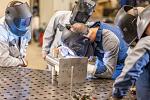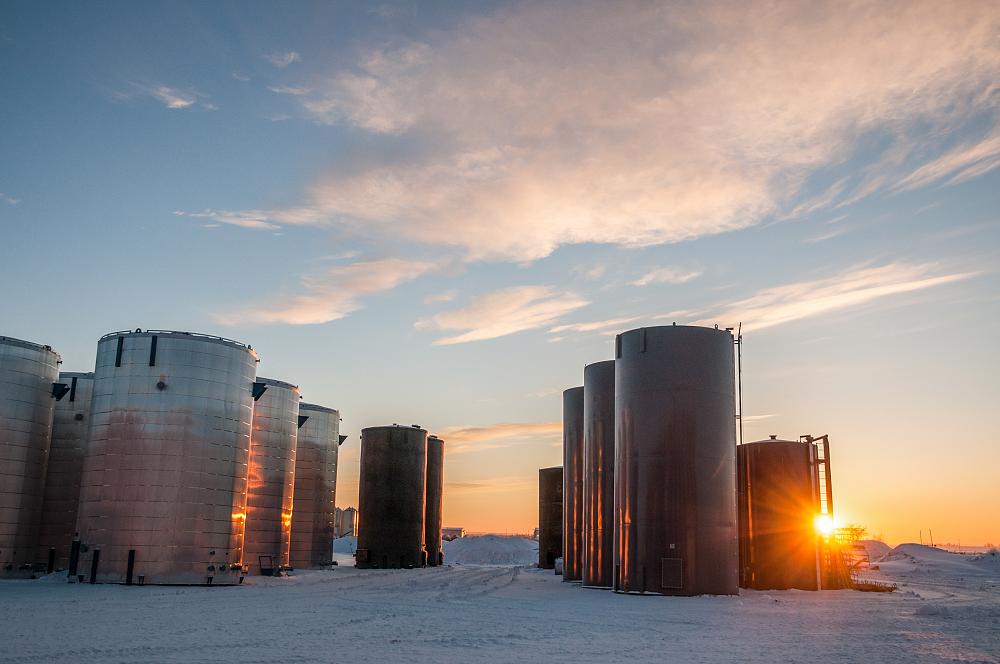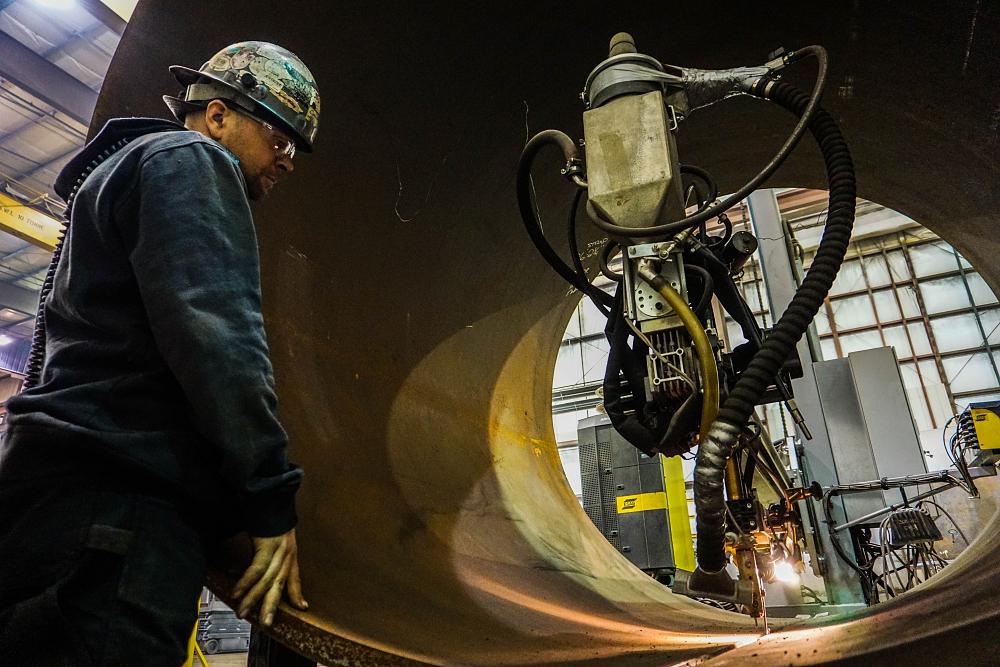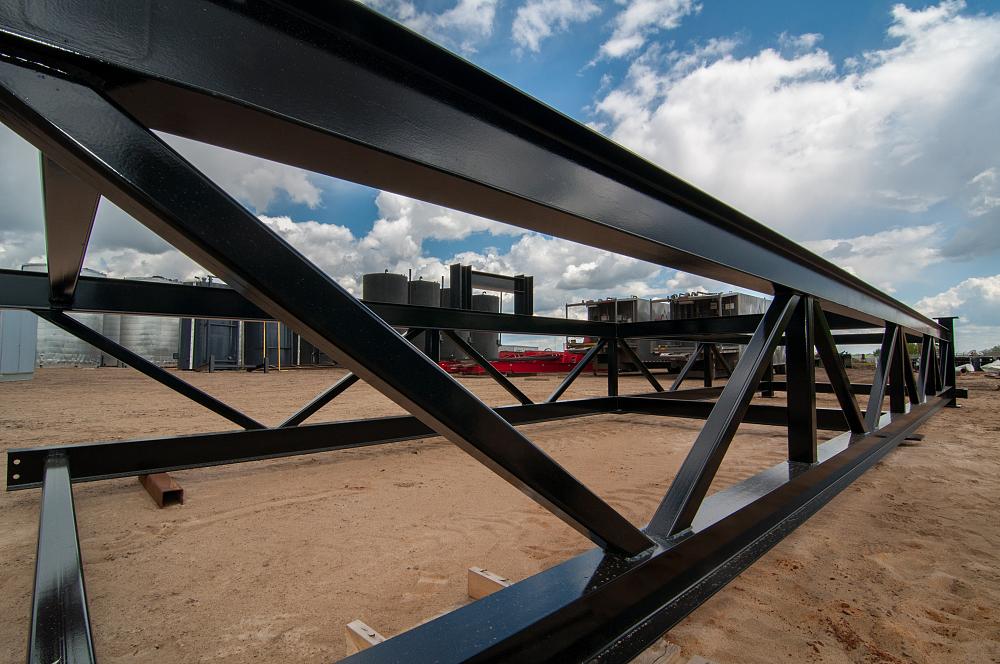- FMA
- The Fabricator
- FABTECH
- Canadian Metalworking
Business Profile: Western Manufacturing
One $27,000 sale in 2009 was the beginning of incredible, rapid growth for Western Manufacturing Ltd. in Hythe, Alta. The oil fabricating company has had revenue growth of 25,719 per cent in the last five years.
- By Sue Roberts
- April 1, 2016
- Article
- Automation and Software

Lonny Thiessen, president of Western Manufacturing in Hythe, Alta., stands among oil tanks waiting for shipment.
Lonny Thiessen, the 29-year-old president of Western Manufacturing Ltd. in Hythe, Alta, has experienced the volatility of serving the oil and gas market, the pleasure and pain of a rapidly growing business, and the satisfaction of turning an idea into a unique product line. He grew up doing odd jobs in his father’s fabricating shop after school, became a welding journeyman at 19, and established Westfab Manufacturing in 2008.
A noncompete agreement slowed his entrepreneurial efforts when he left a management position with a shop serving the oil sands industry, but didn’t stop his progress.
“I had the knowledge and the space but I wasn’t able to get into the oilfield business at the time,” Thiessen said. “That first year we didn’t generate any revenue. We were waiting for oilfield opportunity. One project came along at the end of 2009. We invoiced a total of $27,000 for that year.” That original $27,000 was the seed money that quickly grew into a multimillion-dollar enterprise.
The non-compete clause also prevented Thiessen from using his manufacturing facilities for oilfield projects for a specified period of time. That restriction combined with capital constraints to set the company on a unique path.
“We were pushed towards the contract business model. I began by using the 50- by 80-ft. shop on my uncle’s farm. Within a year we were working with five or six subcontract shops and had built sales, engineering, and marketing teams.
“Using subcontractors allowed us to scale up rapidly with minimal inputs and use capacity available in the local market. There were companies that had people who could fabricate but didn’t have the quality control, sales and marketing, or capital to get started in the oil industry. We brought those components to the table and essentially unlocked their shop potential,” he said.
Rapid Company Growth
Today the company is known as Western Manufacturing, has established itself as a well-known supplier to the oil and gas industry, and has two facilities plus a sister company. The main facility in Hythe has 35,000 sq. ft. of floor space in five separate buildings, eight bays, and 12 acres of storage. The Grande Prairie, Alta., facility has 60,000 sq. ft. of floor space, five bays, and 10 acres of storage. Sister company Steelmax Processing, also in Grande Prairie, has 10,000 sq. ft. of floor space, six bays, and a full complement of equipment to fabricate large, heavy components.
The company has garnered recognition and numerous awards from national and local organizations. For example, the company was named Entrepreneur of the Year in 2014 by the Grande Prairie Chamber of Commerce; for three consecutive years it has been included on the Alberta Venture’s “Fast Growth 50” list; and in 2012, and again last year, Canadian Business’ “PROFIT 500” rated it No. 1 as Canada’s fastest-growing company. The 2015 honor was based on a five-year revenue increase of 25,719 per cent.
Still, Thiessen said, it hasn’t been a smooth ride. The tremendous, rapid growth came at a cost.
“We had steep growth from that original $27,000 of revenue—around $5 million in 2010; $32 million in 2011; and $65 million is 2012. That was our big growth phase and we grew too fast. We didn’t build our infrastructure fast enough and ended up disappointing some customers.
“At the end of 2012 I saw that the amount of money spent on mismanagement would pay for a lot of people. So we tripled our staff in 2013. That was about the same time the industry lagged and our revenue leveled off. We had overcorrected and had to trim staff.
“We also brought on too many green people on the project and engineering side, and that was part of our staffing challenge. But, unlike now when qualified people are working in fast food, I don’t know that we could have found enough experienced people to fill the positions in 2013. The take-away for me--if I did it again, I would put more time and energy into integrating the right people into the company as sales increased.
“It’s been a very interesting cycle. I feel like we are now at a point where we have a cohesive team for the first time since the inception of this business.”
Elevational Supports
The current oil industry downturn caused more trimming but the employee count still tops 80. About 50 employees work in the shops. A sales team based in Calgary serves three segments of the oil and gas customer base—producers, engineers, and field contractors, or constructors. Building structural steel projects for the industry was added this past year.
“It’s a three-pronged approach to build in this industry, and we need to communicate with them all,” said Thiessen. “The producers drill the oil and gas wells. They typically hire engineering companies to manage their projects. Then, specifically on the structural steel side, the engineers will often contract a constructor to manage the installation of equipment and structures in the field. We have to touch a minimum of three companies to sell a structural steel job.”
Structural steel projects built at Western are basically elevational supports—pipe racks, platforms, stairways, and handrails--that surround the tanks and pressure vessels that comprise the company’s main products. Cutting, welding, and finishing are the primary processes involved in project construction.
“A lot of the work that we do is fixturing to handle big plate. We build our own custom tank rolls, or jigs.”
The Hythe facility has an ESAB subarc welding machine paired with pressure rolls, plate rolls, and a lot of plasma cutting and welding capacity. But many of the components are produced at Steelmax, which has a 400-ton press brake, shear, 8- by 30-ft. plasma table, plate rolls, saws, pipe benders, ironworkers, and several welding cells.
A fairly recent addition to support the structural steel side of the business is a Prodevco robotic structural steel, four-sided profiling system. “What’s unique about it,” said Thiessen, “is that it can handle a variety of material, including hollow structural steel, channel beam, and angle iron.”
Larger Shop-built Tanks
A common-size tank built at Western holds 3,000 barrels of oil, measures 40 ft. high, and has a 23-ft. 6-in. diameter.
“We take two pieces of flat plate and join them in the middle, create a large loop of steel, weld it together, and set it in the tank roll system that we developed. We do that with another section and weld the two together, then repeat until we get to 40 ft. Imagine handling a 75-ft. piece of ¼-in. plate. There’s not much stability, so it has to be supported fully with our machinery.
“Our process is basically about innovative fixturing to hold the material in the right place, and material handling. It allows us to build larger tanks.”
The proprietary manufacturing method eliminated the use of large cranes, providing a safer work environment, and allows easier access for welding, resulting in higher-quality welds, faster build times, and a 50 per cent reduction in labour hours.
“We turned the tank-building process on its side. With some novel engineering, we created a unit that helps us construct the largest shop-built tank in the industry.”
Once the shell of the tank has been built, the roof and floor are added. It moves on to fitting, where the external circumference seams are welded and its “jewelry,” components like nozzles and valves, are added. Testing is next. Then finishing.
The type of tank determines what testing processes are needed. Much of it is done in-house, but some projects require third-party testing. “Large-diameter tanks have spot radiography, maybe a little ultrasonic testing, and some magnetic particle inspection. Some piping and pressure vessels require 100 per cent radiography testing. Hydrotests are very common.”
Thirty per cent of Western’s production involves the finishing processes. Finishing tanks is sandblasting-intensive and calls for a significant amount of internal coating. Some tanks are insulated, which requires applying a polyurethane foam spray to the inside walls, and some have an additional internal layer of metal cladding.
Western’s Own Brand
The Whale is Western’s own horizontal atmospheric storage tank. Built on an integrated trailer, it is designed to double the hauling and heating efficiency of mobile tanks used mainly for hydraulic fracturing, or fracking.
A standard Whale holds 230 cubic meters of fluid, has a 2 million BTU burner CSA-certified system that heats the water from 35 to 70 degrees F in 12 hours or less and thermostatically maintains the temperature, and is fully DOT-certified and -inspected. Metal cladding and polyurethane panels give the tanks an R12 insulation value. A sloped bottom construction directs the contents to two sumps that provide 100 per cent clean out.
Aboriginal Student Program
Western’s Hythe facility is located 5 miles from Horse Lake, an aboriginal community. Company location, along with Thiessen’s personal ethics, led to the development of a summer educational program for First Nation students.
“It’s important to me personally to have good relations with the community, and our customers value it highly. They like to know that they are awarding their contracts to a company that employs people from First Nation communities,” Thiessen said. “On the business side, there is such an untapped labour potential there, and our relationship creates value for both sides.”
Western opens its doors to four to six aboriginal youth each year, giving them an opportunity to experience every aspect of the business. They spend a week observing, learning, and assisting with each of the key shop processes, including bending, fitting, and welding; sandblasting and painting; and bolting on the fixtures. The program is continually tweaked based on input from the students.
“At the end of a summer session we ask them what they found most inspiring. If a student is interested in welding, he or she can do a few weeks of welding job shadowing, and we hope to hire them and get them into the apprenticeship program. We hope to bring some of those people forward into their dream careers.”
The current program accepts students just out of high school, but Thiessen is looking at developing a program to introduce adults to industry opportunities through a job-shadowing program.
Expansion and New Markets
Diversification and further company growth are both on the list for the future.
“We are 100 per cent oil and gas-driven right now, and nobody knows what will happen in this industry. Since we want the company to continue to grow, we are looking at expanding our customer base,” Thiessen said.
Meantime, another shop dedicated to producing large-diameter API tanks is planned for the Hythe location. “We think the slow time is a good time to add capacity and prepare for the future. We are planning, hoping, and setting our trajectory to have growth in the next 24 months.
“Western has had its success due to the people, the team, their dedication and commitment. If a company can attract the right people and inspire them with the vision of creating change and good, it will go a long way. The sheer energy and strength of our people drive us forward.”

The Whale mobile tank, a Western innovation, accommodates the same volume as two 400-BBL tanks within the same trucking dimensions.
Photos courtesy of Western Manufacturing.
Western Manufacturing, 780-356-2599, www.westernmanufacturing.ca
About the Author

Sue Roberts
2135 Point Blvd
Elgin, IL 60123
815-227-8241
Sue Roberts, associate editor, contributes to both Canadian Metalworking and Canadian Fabricating & Welding. A metalworking industry veteran, she has contributed to marketing communications efforts and written B2B articles for the metal forming and fabricating, agriculture, food, financial, and regional tourism industries.
Roberts is a Northern Illinois University journalism graduate.
subscribe now


Keep up to date with the latest news, events, and technology for all things metal from our pair of monthly magazines written specifically for Canadian manufacturers!
Start Your Free Subscription- Trending Articles
Class is in session for college connections

BlueForge Alliance partners with Nuts, Bolts & Thingamajigs to develop Submarine Manufacturing Camps

Portable system becomes hot tech in heat treatment

Orbital tube welding webinar to be held April 23

Cidan Machinery Metal Expo 2024 to be held in Georgia May 1-2

- Industry Events
MME Winnipeg
- April 30, 2024
- Winnipeg, ON Canada
CTMA Economic Uncertainty: Helping You Navigate Windsor Seminar
- April 30, 2024
- Windsor, ON Canada
CTMA Economic Uncertainty: Helping You Navigate Kitchener Seminar
- May 2, 2024
- Kitchener, ON Canada
Automate 2024
- May 6 - 9, 2024
- Chicago, IL
ANCA Open House
- May 7 - 8, 2024
- Wixom, MI



















